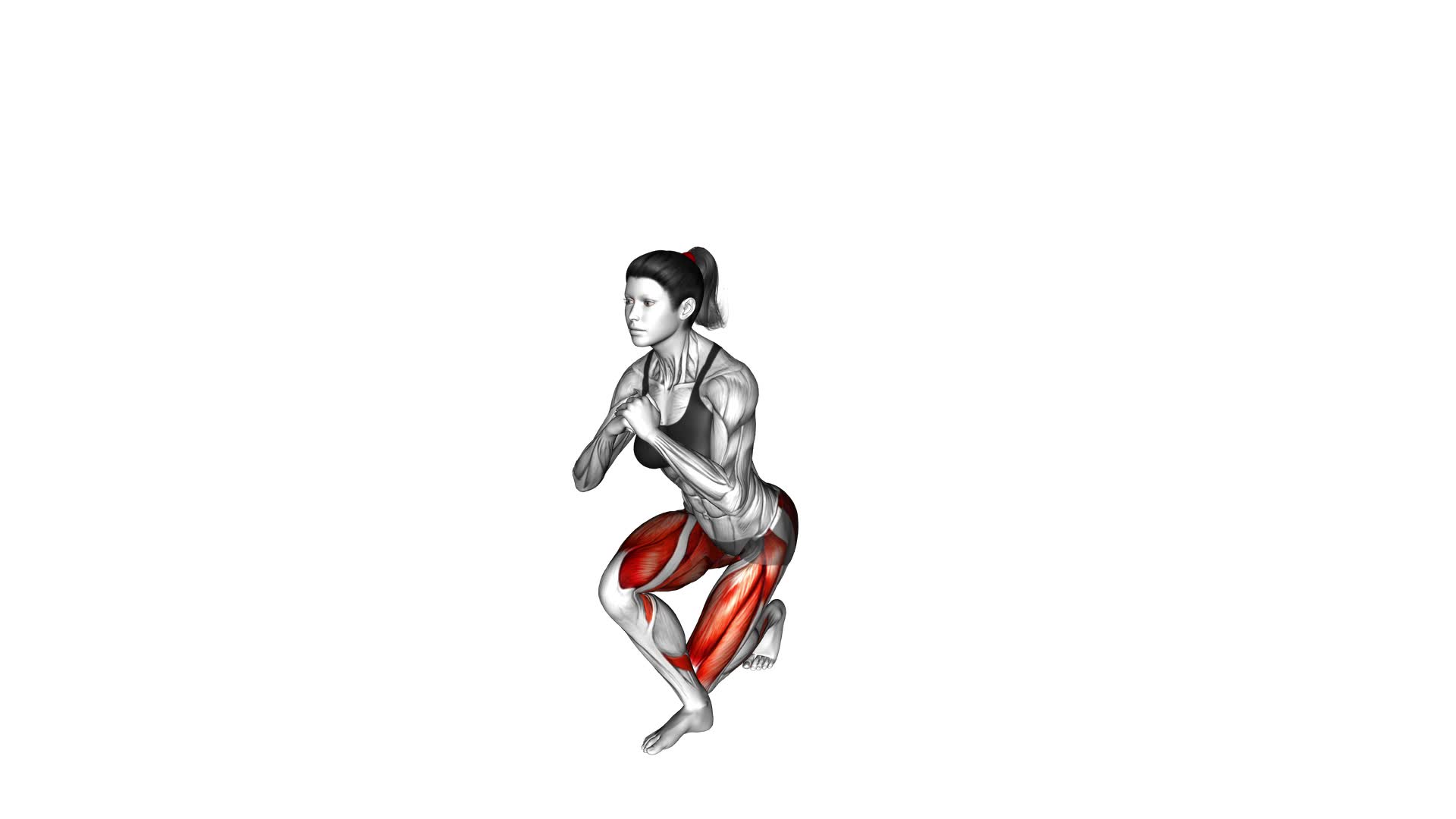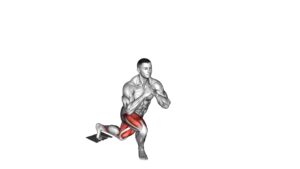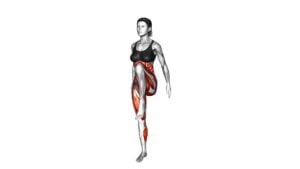Single Curtsy Lunge (female) – Video Exercise Guide & Tips

Get ready to tone and strengthen your legs with the Single Curtsy Lunge. This video exercise guide provides step-by-step instructions and helpful tips to ensure you perform the exercise correctly.
Watch This Exercise Video
Learn about the benefits of the Single Curtsy Lunge, common mistakes to avoid, and variations to keep challenging yourself.
Watch the video and get the most out of your workouts with this effective leg exercise.
Let's get started!
Key Takeaways
- The single curtsy lunge improves lower body strength and stability.
- It targets the glutes, quadriceps, hamstrings, and calves.
- The exercise shapes and strengthens the gluteus maximus.
- Proper form and technique are important to maximize effectiveness and avoid common mistakes.
Benefits of the Single Curtsy Lunge
To understand the benefits of the Single Curtsy Lunge, it's important to recognize how this exercise can improve your lower body strength and stability. The Single Curtsy Lunge is a variation of the traditional lunge exercise that targets several key muscles in your lower body.
By incorporating different lunge variations into your workout routine, such as the Single Curtsy Lunge, you can challenge your muscles in new ways and achieve better overall strength and stability.
The primary muscles targeted in the Single Curtsy Lunge are the glutes, quadriceps, hamstrings, and calves. This exercise specifically activates the gluteus maximus, which is the largest muscle in your buttocks, helping to shape and strengthen this area. The quadriceps, located in the front of your thighs, are also engaged during the Single Curtsy Lunge, helping to strengthen and tone your legs. Additionally, the hamstrings and calves are activated to provide stability and balance throughout the movement.
By regularly performing the Single Curtsy Lunge, you can expect to see improvements in your lower body strength, stability, and overall muscle tone. Incorporating different lunge variations into your exercise routine can help prevent boredom and plateaus by challenging your muscles in new ways.
Proper Form and Technique for the Single Curtsy Lunge
To perform the Single Curtsy Lunge with proper form and technique, focus on maintaining balance, engaging your core, and executing the movement smoothly and controlled. Start by standing with your feet hip-width apart and your hands on your hips. Take a step diagonally behind you with your right foot, crossing it behind your left leg. Bend both knees as you lower your body down into a lunge position, aiming to have your right knee touch the ground. Keep your torso upright and your chest lifted throughout the movement. Push through your left heel to return to the starting position. Repeat on the other side by stepping diagonally behind with your left foot.
To modify the Single Curtsy Lunge, you can use a chair or wall for support. Hold onto the chair or place your hand against the wall for balance as you perform the movement. This can help you maintain stability and prevent any wobbling or falling.
If the Single Curtsy Lunge is too challenging or not suitable for you, there are alternative exercises that target similar muscle groups. Lunges, reverse lunges, and side lunges are all great alternatives that work the lower body and can be modified to your fitness level. Remember to always listen to your body and choose exercises that are appropriate for you.
Common Mistakes to Avoid
Avoid these common mistakes when performing the Single Curtsy Lunge to maximize the effectiveness of your workout and prevent injuries. Here are some modifications and alternatives to help you avoid these mistakes:
- Not maintaining proper form: Make sure to keep your back straight, chest lifted, and core engaged throughout the exercise. Avoid rounding your shoulders or leaning forward.
- Overextending the front knee: To protect your knee joints, avoid letting your front knee extend past your toes. Instead, focus on bending both knees to a 90-degree angle.
- Neglecting the back leg: Many people tend to forget about the back leg during the Single Curtsy Lunge. Ensure that you're actively engaging the muscles of the back leg by pushing through the heel and squeezing the glutes.
- Rushing through the movement: Take your time and perform each rep with control. Rushing through the exercise increases the risk of losing balance and decreases the effectiveness of the lunge.
Modifications and alternatives: If you find the Single Curtsy Lunge too challenging or need to modify due to any physical limitations, you can try the following:
- Perform the lunge with a chair or wall for support.
- Use lighter weights or no weights at all.
- Decrease the range of motion by not lunging as deeply.
Variations and Progressions for the Single Curtsy Lunge
In the previous subtopic, we discussed common mistakes to avoid when performing the Single Curtsy Lunge to maximize effectiveness and prevent injuries. Now, let's explore the various variations and progressions you can incorporate into your Single Curtsy Lunge routine to take your workout to the next level.
To add variety to your workout, you can try different curtsy lunge variations. One option is the Reverse Curtsy Lunge, where instead of crossing your leg behind, you step back diagonally. This targets your glutes and outer thighs in a slightly different way. Another option is the Weighted Curtsy Lunge, where you hold dumbbells or kettlebells in your hands to increase the resistance and challenge your muscles further.
If you're looking for advanced curtsy lunge progressions, you can try the Jumping Curtsy Lunge. This explosive movement adds a plyometric element to your workout, increasing intensity and calorie burn. Another progression is the Curtsy Lunge with Knee Drive, where after performing the curtsy lunge, you lift your back leg and drive your knee up towards your chest, engaging your core and improving balance.
Remember to always prioritize proper form and technique when attempting these variations and progressions. Start with lighter weights or lower impact options and gradually increase the difficulty as you become more comfortable and confident.
Tips for Getting the Most Out of Your Single Curtsy Lunges
Maximize your results by incorporating these effective tips into your single curtsy lunges.
- Focus on improving stability: To get the most out of your single curtsy lunges, it's important to work on your stability. Engage your core muscles and maintain a strong, balanced stance throughout the movement. This will help you target the correct muscles and prevent injury.
- Increase glute activation: To really target your glutes, focus on squeezing your glute muscles as you push back up from the lunge position. This will help to activate and strengthen your glutes, leading to better results.
- Maintain proper form: Proper form is key to getting the most out of any exercise, including single curtsy lunges. Keep your chest lifted, shoulders back, and maintain a 90-degree angle in your front and back knees. This will ensure that you're targeting the correct muscles and maximizing the effectiveness of the exercise.
- Gradually increase intensity: As you get stronger, challenge yourself by increasing the intensity of your single curtsy lunges. This can be done by adding weights, performing the exercise on an unstable surface, or increasing the range of motion. By gradually increasing the intensity, you'll continue to see improvements in strength and muscle tone.
Frequently Asked Questions
How Many Calories Does the Single Curtsy Lunge Burn?
The single curtsy lunge is a great exercise for burning calories and improving balance. It targets your glutes, quads, and hamstrings, making it an effective calorie-burning move.
By incorporating this exercise into your workout routine, you can increase your calorie burn and work on your balance at the same time.
Can the Single Curtsy Lunge Help Improve Balance?
Improving stability is a key benefit of the single curtsy lunge. By engaging your core and lower body, this exercise helps strengthen the muscles needed for better balance.
If you're a beginner, there are variations available to make it more manageable. Practice proper form and gradually increase the intensity as you become more comfortable.
With consistency, the single curtsy lunge can be a valuable addition to your fitness routine.
Is It Necessary to Warm up Before Performing the Single Curtsy Lunge?
Before performing any exercise, it's important for you to warm up. Warming up helps prepare your body for the physical activity ahead and reduces the risk of injury.
Incorporating dynamic stretches in your warm-up routine can further enhance the benefits. Dynamic stretches help increase blood flow to your muscles, improve range of motion, and activate the muscles you'll be using during the exercise.
Can the Single Curtsy Lunge Target Specific Muscles?
The single curtsy lunge can target specific muscles in your lower body, such as your glutes, hamstrings, and quads. By crossing one leg behind the other in a curtsy-like motion, you engage these muscles in a unique way.
This exercise also offers several benefits, including improved balance, increased hip mobility, and enhanced overall lower body strength.
Additionally, there are variations of the single curtsy lunge that can add variety and challenge to your workout routine.
Are There Any Modifications for Individuals With Knee or Hip Pain?
If you're experiencing knee or hip pain, there are modifications and alternative exercises you can try.
When it comes to modifications, you can try reducing the depth of the lunge or using a support, like a chair or wall, to help with balance.
Alternatively, you can opt for exercises that put less strain on the knees and hips, such as glute bridges or step-ups.
Remember to listen to your body and consult with a professional if needed.
Conclusion
In conclusion, the single curtsy lunge is a highly effective exercise that targets the glutes, quadriceps, and hamstrings.
By practicing proper form and technique, avoiding common mistakes, and incorporating variations and progressions, you can maximize the benefits of this exercise.
Remember to focus on maintaining balance, engaging your core, and breathing properly throughout the movement.
By following these tips, you can ensure that you're getting the most out of your single curtsy lunges and achieving your fitness goals.

Author
Years ago, the spark of my life’s passion ignited in my mind the moment I stepped into the local gym for the first time. The inaugural bead of perspiration, the initial endeavor, the very first surge of endorphins, and a sense of pride that washed over me post-workout marked the beginning of my deep-seated interest in strength sports, fitness, and sports nutrition. This very curiosity blossomed rapidly into a profound fascination, propelling me to earn a Master’s degree in Physical Education from the Academy of Physical Education in Krakow, followed by a Sports Manager diploma from the Jagiellonian University. My journey of growth led me to gain more specialized qualifications, such as being a certified personal trainer with a focus on sports dietetics, a lifeguard, and an instructor for wellness and corrective gymnastics. Theoretical knowledge paired seamlessly with practical experience, reinforcing my belief that the transformation of individuals under my guidance was also a reflection of my personal growth. This belief holds true even today. Each day, I strive to push the boundaries and explore new realms. These realms gently elevate me to greater heights. The unique combination of passion for my field and the continuous quest for growth fuels my drive to break new ground.



